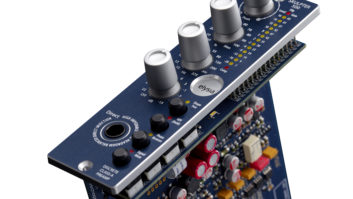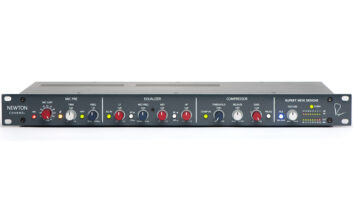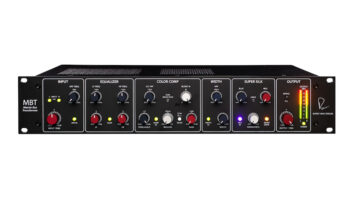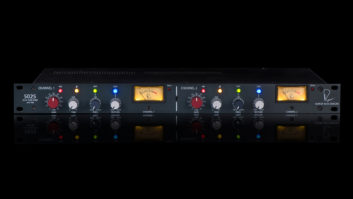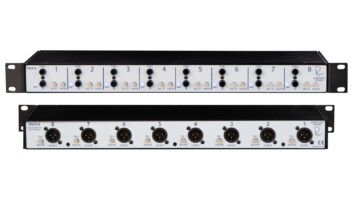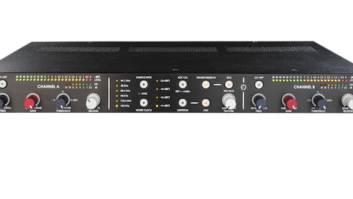
It’s a safe assumption that any gear with the name Rupert Neve attached to it is going to be of the highest quality, and that’s certainly the case with the new 5211 mic preamp. Unveiled at AES 2018, it’s a dual-channel mic pre that combines excellent sound quality, smart design and a flexible feature set. The unit offers sound ranging from ultra-clean to heavily transformer-saturated.
According to the company, the 5211 is a reimagined version of the Portico 5012, which, back in 2005, was the first product released under the name Rupert Neve Designs (RND). The 5211 also features the same output transformers developed for the company’s flagship Shelford Channel. Those are two solid legacies.
A single-rackspace unit, the 5211 sports the same darkish green-gray color of the Shelford Channel. All controls (except the on/off switch) are on the front; all I/O is on the back.
Each channel offers the same control set, mirrored on the left and right sides of the front panel. On the left side of each channel is a stepped input Gain control switch that features 12 settings ranging from 0 to 66 dB (the full gain spec of the unit is 72 dB). You can modify those with a Trim knob that provides ±6 dB of continuously variable control.
Switches, Knobs and Silk
Each channel has its own output meter, which, while small, is easy to read and quite informative. The meters are 8-segment LED bar graphs that feature five green lights, two amber and a red. The green lights represent levels of –10 dBu to +10 dBu; the amber +14 dBu and +18 dBu; and the red +22 dBu. If you light up the red, you’re 3 dB short of clipping. A peak hold feature keeps it lit longer to give you a clear warning to reduce the input level.
As would be expected in a unit of this quality, each channel has its own 48V phantom power switch. The phantom power is a little noisy when you turn it off, making a short series of popping sounds, so it’s best to have the speakers turned down when doing so.
The HPF button activates a channel’s highpass filter, allowing you to roll off unwanted low end. It lights up green when activated, which makes it nearly impossible to record with it on unless you want to. In the 5211’s signal chain, the filter is after the Trim control, but before the Silk (saturation) circuit. The Filter knob lets you select the cutoff frequency, which can range between 20 and 250 Hz. You also get a Polarity switch for each channel. When engaged, the switch lights up yellow.
There are two controls for the Silk circuit, which is also the final stage before the output. When you turn on its activation switch, it lights up red to let you know that it’s engaged. You then use the detented Texture knob to dial in as much or as little of the Silk effect as you want.
Rupert Neve Designs has employed the Silk circuit in various forms in other products. It produces transformer-saturation, particularly in the mid- and high-frequency ranges. According to RND, the Silk circuitry used on the 5211 and the Shelford Channel are not precisely the same, though awfully similar.

All About Connections
Both of the inputs on the 5211 are of the XLR mic variety, and both are on the back panel. The unit doesn’t have XLR/1/4-inch combo jacks or any separate high-impedance inputs, though its inputs are also able to handle line-level signals, thanks to the ability to manage levels of up to +26 dBu without the need for a pad.
If you want to connect a guitar, bass or other high-impedance source, you’ll need to go through a DI box first. The lack of a DI input might be inconvenient for some home studio users who want to use the 5211 as the front end of their system.
The 5211 was designed to capture the purest input signal possible, which is why there are no transformers on the inputs. That differs from the Shelford Channel, and with the classic Neve 1073, for that matter, which both have input transformers. The company’s philosophy for the 5211 is to provide the user with the option of a clear, open sound or to add transformer saturation via the Silk circuitry and by driving the output transformer.
The latter can be achieved through the “Dual Tap” architecture, which provides a second, lower-headroom output for each channel. These additional outputs have –6 dB of headroom as opposed to +26 dBu on the primary outs. When you use the lower-headroom outputs, it’s possible to drive the transformers harder to achieve saturation without clipping the devices that are connected, such as interfaces, mixers and converters.
Besides the I/O, the back panel is home to the IEC power jack, a ground lift switch and the power on/off switch.
Want more stories like this? Subscribe to our newsletter and get it delivered right to your inbox.
In Action
I tested the 5211 over a couple of months, using it to record a variety of sources, including vocals, acoustic guitar, Dobro, electric guitar amp and DI, bass DI, congas, tambourine, log drum, guiro and shaker. I made a lot of comparisons between the unit with the Silk on at various settings and with it off. I also compared the sound through the +26 dBu output and the –6 dB output, and with other preamps in my studio.
My overall impression was that, with the Silk off, the 5211 is transparent and quite clean, and when paired with a good microphone (or microphones), captures the full frequency range of instruments and voices in a way that my other (admittedly less expensive, although not cheap) preamps can’t. I noticed this in particular on acoustic guitar and Dobro, both of which sounded excellent and very natural through the 5211.
The Silk circuit was not quite as dramatic as I expected, but that may be due more to my expectations than its capabilities. Considering that Rupert Neve Designs says it’s 10 times as saturated as the Silk circuit in the original 5012, perhaps I was expecting too much. That being said, it definitely provided a more saturated and transformer-like sound. When cranked, it added a pleasant edge to the sound that brought a little extra oomph, particularly on vocals.
Having the highpass filter so readily available was handy, especially when recording sources that tend to be boomy, like acoustic guitar.
Final Thoughts
Having never used the Portico 5012, I can’t compare it anecdotally to the 5211, but from a feature and spec standpoint, the new unit represents a significant improvement on its predecessor. While its price tag may seem a little high to some, consider that you’re getting Rupert Neve sound and features for under $1,000 per channel, which is a pretty good value.
If you’re a home studio owner, investing in a 5211 could be a wise move, as it will provide you with a super-high-quality and versatile front end, which, when coupled with good mics and a quality interface, will help ensure that your recordings can stand up to the competition. What’s more, you can be sure that it will hold its value over the years.
Product Summary
Company: Rupert Neve Designs
Product: 5211
Website: rupertneve.com
Price: $1,995
Pros: Two channels of high-quality tone; adjustable between clean and transparent and transformer saturated; secondary, –6 dB outputs allow you to drive the input harder for more saturation; highpass filters on the front panel; well-designed meters and indicators; good value for a quality front end
Cons: No DI input; phantom power makes popping noises when turned off
